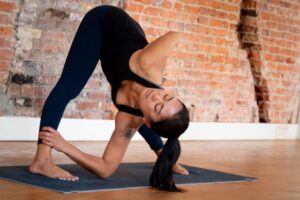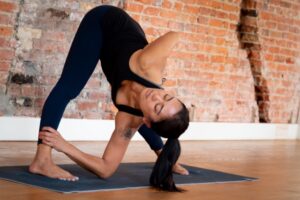 Meet Mana, beloved Yoga District teacher and a valued member of our community. Mana was recently nominated in Washington City Paper’s “Best Of” for Best Yoga Instructor in the greater DC area. Learn how Mana discovered yoga on a trip through Southeast Asia, and how she became the teacher she is today.
Meet Mana, beloved Yoga District teacher and a valued member of our community. Mana was recently nominated in Washington City Paper’s “Best Of” for Best Yoga Instructor in the greater DC area. Learn how Mana discovered yoga on a trip through Southeast Asia, and how she became the teacher she is today.
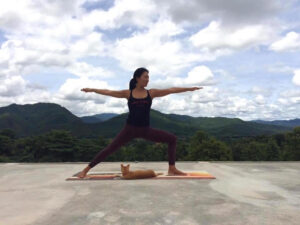 Yoga Journey
Yoga Journey
After leaving a creative director/consulting position in the fashion industry in Tokyo, I traveled for two months in Southeast Asia. While traveling, I began attending a local yoga studio. Even when I returned to Tokyo, I continued to study yoga, but then moved to Chiang Mai, Thailand to get closer to my true nature. Moving to a new country to start a new job and make new friends really shows you who you are. I needed a new perspective to realize how many layers I was wearing that I didn’t need. Ever since, I’ve continued to study and practice yoga, and have taught classes from Thailand to Laos, Japan, and now the US.
Yoga creates a space to show up authentically as yourself, which inspires us to hold onto that authenticity after we step off the mat. It has taught me to hold space for whatever thoughts or feelings arise within me. To also cultivate compassion for myself and others. To just be me.
My life as a yoga pose would be Samastitihi (tadasana) (2). It is a neutral pose that creates space while also grounding us. Samastitihi allows us to broaden our perspectives and build energetic power in ourselves.
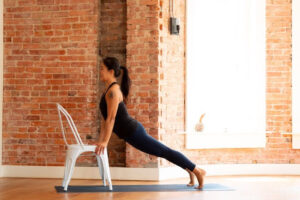 Teaching Yoga: Yoga for All
Teaching Yoga: Yoga for All
I’ve always loved the ability to carry the energy I create on the mat with me the rest of the day. Yoga and meditation bring me joy and peace. I simply want to share those feelings with other people.
When I started teaching in the US, I took notice of the diversity of students within my classes. It was amazing that there were so many different types of bodies and levels of ability! It contrasted with my previous Yoga training in which we didn’t learn much about teaching to different levels of ability. The truth was that I didn’t know much about how to instruct bigger bodies, older folks, and people with injuries. I feared that if I stopped to help a small group or one student, I would displease the majority. So, I started to listen to podcasts, read books, and took additional workshops and training. I am continuing to work on creating spaces that are welcoming to people of every size, color, age, and gender.
Also, I learned that there are so many optional variations of poses, and I am a big fan of using props in a pose. I practice the Iyengar tradition, which tends to use blocks or straps to help with alignment (1). Even when practicing “traditional” Ashtanga, you can still use props or pose variations. Regardless of your age, size, or ability, I believe an advanced practitioner has deeper awareness, a strong connection with mind and body, as well as a sophisticated practice. They are not necessarily more skilled in advanced poses.
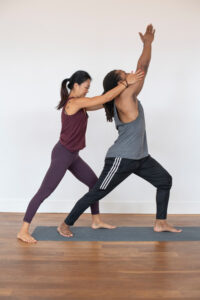 Teaching Yoga Online: Communal and Global Experience
Teaching Yoga Online: Communal and Global Experience
My favorite style to teach is Ashtanga Mysore (3). In a Mysore practice, students practice a series of asanas, or poses, at their own pace (4). This is the main practice I teach, and I enjoy helping students cultivate this practice. Ashtanga Mysore becomes more customizable with each individual who experiences the practice.
In these classes, I try to create a welcoming Ashtanga class that is accessible for all by offering many variations and other options. I focus on fundamental standing poses, seated poses, and a series of backbends. My vinyasa flow classes combine high energy and mindful breath to cultivate mind and body connection. Simple movements and moments of stillness can really create strength and peace of mind.
My favorite thing about teaching yoga online is that I can teach from anywhere in the world! My introduction to yoga came from traveling. I have studied, practiced, and taught yoga as I’ve traveled all over the world. Teaching yoga online can broaden the possibilities for both teachers and students.
With online classes, you have more possibilities to choose your favorite teachers from anywhere in the world, and students can join from wherever they are. In one of my online classes, we had students from Singapore, Europe, Thailand, LA, and Japan. It was so cool!
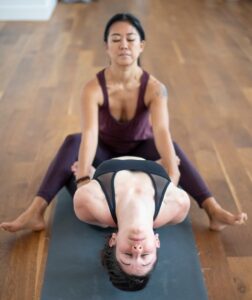 Empowering Students
Empowering Students
I’ve found that the headstand pose can create a feeling of empowerment within my students (5). It’s not the easiest pose, and overcoming the fear of falling doesn’t always feel natural. But, the inversion requires students to trust their strength both mentally and physically. They need to connect their mind and body. This pose also reminds us to remain gentle with ourselves when we inevitably lose balance.
Also, remember that even if we’re connecting through a screen, we can still create community and strengthen our practice together. I encourage students to tap into that connection, see the community, and uplift each other as we share our class together.
Check out Mana’s current class offerings and sign up here!
- Monday, 6:30 AM: Ashtanga Mysore Style @ 14th St Studio and online
- Monday, 12:10 PM: Ashtanga Flow @ Petworth Studio and online
- Tuesday, 6:30 AM: Ashtanga Mysore Style @ 14th St Studio and online
- Wednesday, 12:10 PM: Ashtanga Flow 1.5-2 @ Petworth Studio and online
- Thursday, 6:30 AM: Ashtanga Mysore Style @ 14th St Studio and online
- Thursday, 6:30 PM: All Levels Flow @ Petworth Studio and online
- Friday, 12:15 PM: Flow Express All Levels @ Petworth Studio and online
- Sunday, 9:00 AM: Ashtanga Led Primary 1.5-3 @ online only
- Sunday, 12:45 PM: Ashtanga Flow 1.5-3 @ H St Studio and online
Sources
- Iyengar Yoga, https://www.yogapedia.com/definition/5017/iyengar-yoga
- Samastitihi, https://www.yogapedia.com/definition/6429/samasthiti
- Mysore style, https://www.yogapedia.com/definition/8559/mysore
- Asana, https://www.yogapedia.com/definition/4951/asana
- Headstand, https://www.yogapedia.com/definition/6288/headstand

